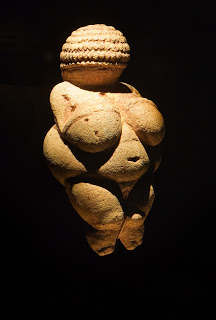
100 Fat Activists #1: The Venus of Willendorf
To celebrate the publication of my book, Fat Activism: A Radical Social Movement, I am doing a series of blog posts about some of the stuff I came across during the research period that people might not otherwise get to see. I’m ripping off the BBC project, in association with The British Museum, called A History of the World in 100 Objects, in that there are 100 things, I’m listing them in more or less chronological order, and it will take me a year or so to blog ’em all. But that’s where the similarity ends. Where that list is founded on a series of values I don’t share, this one is queerer, more feminist and more unruly.
1. The Venus of Willendorf
The Venus is a statue of a fat black woman that was dug up by archeologists in Austria in 1908. She’s at least 25,000 years old, and maybe the earliest carving of a human. She’s fat and I’m not talking chubby.
She’s an important figure for fat activists because she shows that people have known what a fat person looks like for a very long time. She disproves the rhetoric, popularised by the War on ObesityTM that fat people are a recent aberration, the product of junk lifestyles.
I’m calling her a black woman because of what I take to be her hair, it looks braided and black to my 21st century eyes. There are counter-claims that her head might not be a head at all, but a handle for an object. It is important to make people of colour visible within fat activism, and it would make sense that this figure who represents a root of some kind, should be black within a present-day activist rhetoric of centring black people. Maybe activists of another time would see her differently. In claiming her as black, fat activists might also want to critique the naming of her as venus (there are other venus figurines too), which has racialised connotations, and her positioning and interpretation within Western archaeology.
Edited to add: Karen D. has noted that the Venus can also be seen as disabled. This makes me think about how much of her is obscured by taken for granted claims.
Whether the Venus herself is a fat activist is also fodder for conjecture. She’s usually called a fertility goddess, perhaps based on colonial anthropological assumptions about fat black femininity and the depiction of genitals. My feeling is that she could represent anything because the person or people who made her are now dust themselves, and people now will never know about her original context. Interpretation is all we have. To me, her existence is enough in itself and, as far as I’m concerned, it all starts with her.
What I do know is that she remains a powerful figure. You can go and see her in the Naturhistorisches Museum in Vienna. You might also want to search for vernacular images of her online, Venus of Willendorf tattoos, for example, or Venus of Willendorf crafting. I like it when people embellish her by adding feet, a face, a setting, nipples or whatever. Sometimes she’s fatter or has bigger tits, as though people now want her to be more than she is. This perpetual re-engagement shows that she is still relevant and that her age just makes her all the more compelling.
Image credit: Jorge Royan
(c) Obesity Timebomb – Read entire story here.


